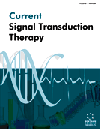- Home
- A-Z Publications
- Current Signal Transduction Therapy
- Previous Issues
- Volume 1, Issue 3, 2006
Current Signal Transduction Therapy - Volume 1, Issue 3, 2006
Volume 1, Issue 3, 2006
-
-
STAT3: A Molecular Target for Cancer Whose Time Has Come
More LessSignal transducer and activator of transcription (STAT) proteins are latent cytoplasmic proteins that transmit cell-surface signals generated by ligand-receptor interactions to the nucleus. They are activated mainly by phosphorylation. Of the STAT proteins, STAT3 and to a lesser extent STAT5, is associated with transformed cells, particularly in tumors arising from oncogenes that activate tyrosine kinase signaling pathwa Read More
-
-
-
n-3 Polyunsaturated Fatty Acids as Signal Transduction Modulators and Therapeutical Agents in Cancer
More LessAuthors: Gabriella Calviello, Simona Serini and Paola PalozzaEpidemiological and experimental studies have established the beneficial effects of n-3 polyunsaturated fatty acids (PUFAs) on cancer. In particular, wide information is available regarding their effects on hormone responsive tumors, such as prostatic and mammary cancer, and tumors originating from colon. Recent studies have focused upon the improvement of chemotherapy effects when different drug treatments ar Read More
-
-
-
Emerging Role of Stromal Fibroblasts in Epithelial Cancer
More LessAuthors: Maria Rita Rippo, Antonio Procopio and Alfonso CatalanoThe mechanisms involved in the tumor-stroma interaction during carcinoma progression are an area of intensive investigation. Cancer cells produce a range of growth factors and proteolytic enzymes that modify their stromal environment. These factors disrupt normal tissue homeostasis and act in a paracrine manner to induce angiogenesis and inflammation, as well as activation of surrounding stromal cell ty Read More
-
-
-
Targeting Prenylated RAS Modifying Enzymes in Cancer Cells
More LessRAS oncogenes have been identified in about 30% of all human cancers, particularly in 90% of human pancreatic cancers, 50% of colorectal tumors, and 30% of lung cancers. RAS is a central switch for many signal transduction pathways. The RAS proteins undergo three major posttranslational modification steps to become fully functional: prenylation (farnesylation or geranylgeranylation) of the cysteine residue Read More
-
-
-
Targeting Phospholipase D-mediated Survival Signals in Cancer
More LessAn important component of tumor progression is the generation of “survival signals” that suppress default apoptotic programs. Survival signals are ideal targets for anticancer therapeutic strategies because blocking survival signals, in principle, can resurrect the apoptotic signals that are suppressed in cancer cells. Phospholipase D (PLD) activity, which is elevated in a large variety of cancers, generates a survival signal tha Read More
-
-
-
The Role of Heat Shock Protein 90 and Endothelial Nitric Oxide Synthase Signaling in Cardiovascular Therapy
More LessAuthors: Tennille Presley, Periannan Kuppusamy, Jay L. Zweier and Govindasamy IlangovanThe 90 kDa heat shock protein, Hsp90, is a critical protein in eukaryotes. Mainly cytosolic, this protein is expressed at extraordinary levels and participates in the folding of specific protein substrates. Hsp90 is well preserved and exhibits a chaperone role in the conformational maturation in the cellular stress response, and the nuclear hormone receptors and protein kinases. This protein regulates signal transducing molecule Read More
-
-
-
PDX-1 and MafA as Potential Therapeutic Targets for Diabetes
More LessAuthors: Hideaki Kaneto, Takeshi Miyatsuka and Taka-aki MatsuokaPancreatic and duodenal homeobox factor-1 (PDX-1) plays a crucial role in pancreas development and β-cell differentiation, and functions as an activator of insulin gene transcription. MafA is a recently isolated β-cell-specific transcription factor which functions as a potent activator of insulin gene transcription. PDX-1 and MafA play crucial roles in inducing insulin-producing cells from non- β-cells and could be therapeutic targe Read More
-
-
-
Carotenoids as Modulators of Intracellular Signaling Pathways
More LessAuthors: Paola Palozza, Simona Serini and Gabriella CalvielloCarotenoids have been proposed to exert beneficial effects in several chronic diseases, including cancer and cardiovascular diseases. Many of the biological actions of carotenoids have been attributed to their antioxidant properties, through the antioxidant capacity of the carotenoid molecule per se or through their possible influences on intracellular redox status. However, the exact mechanism by which carotenoids exert their Read More
-
-
-
Biology and Impact of Signal Transducers and Activators of Transcription and Their Regulators as Targets in Cancer Therapy
More LessAuthors: Edith Pfitzner, Frank Nonnenmacher and Daniela BausWhile chemo- and radiotherapy is far developed and successfully employed by default for cancer treatment, severe side effects point to the urgent need for more specific therapies based on the molecular mechanisms of this disease. Strategies to specifically inhibit signaling pathways that are known to force proliferation, prevent apoptosis or promote angiogenesis are expected to have a substantial impact on the future directi Read More
-
Volumes & issues
-
Volume 20 (2025)
-
Volume 19 (2024)
-
Volume 18 (2023)
-
Volume 17 (2022)
-
Volume 16 (2021)
-
Volume 15 (2020)
-
Volume 14 (2019)
-
Volume 13 (2018)
-
Volume 12 (2017)
-
Volume 11 (2016)
-
Volume 10 (2015)
-
Volume 9 (2014)
-
Volume 8 (2013)
-
Volume 7 (2012)
-
Volume 6 (2011)
-
Volume 5 (2010)
-
Volume 4 (2009)
-
Volume 3 (2008)
-
Volume 2 (2007)
-
Volume 1 (2006)
Most Read This Month
Article
content/journals/cst
Journal
10
5
false
en


